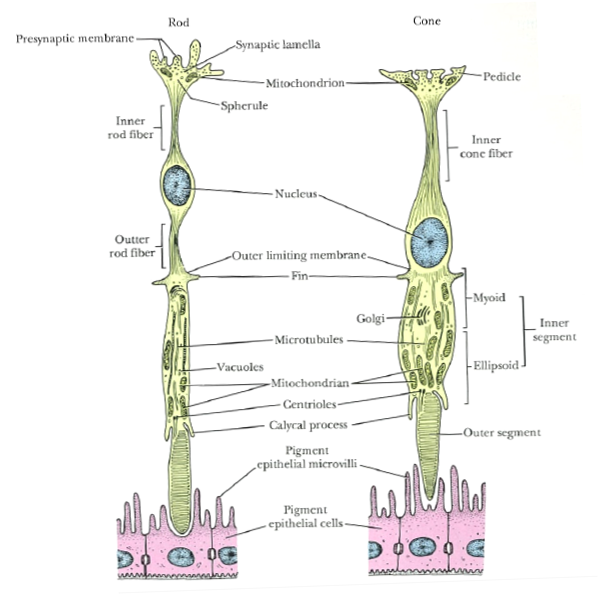Rods and cones
Rods and cones are the two major types of sensory cells in the eye and are located in the outer most later of the retina, closest to the choroid.
Figure 1: Diagram of rod and cone cells. Outer segments of rods and cones are closely associated with adjacent pigment epithelium.
Rods and cones are the two major types of sensory cells in the eye and are located in the outer most later of the retina, closest to the choroid.
Figure 1: Diagram of rod and cone cells. Outer segments of rods and cones are closely associated with adjacent pigment epithelium.
Source: Ross M.H. and Pawlina W. (2006) Histology a text and atlas with correlated cell and molecular biology, 5th edn., Baltimore: Lippincott Williams & Wilkins.
Rods
- Do not provide colour vision
- Extremely sensitive
- In poor light conditions à all vertebrae see in black, white and grey
- In very bright conditions à lose ability to discriminate between light intensities
Cones
- Colour vision
- Stimulated only in good light conditions i.e. level at which rods are maximally stimulated
- Ability to provide detailed vision in full daylight (photopic vision)
- Area centralis of diurnal species have high number of cones
Humans
- Density of cones are high in the fovea in the middle of the area centralis
- Fovea in humans contain only cones à visual acuity in fovea is high
- As fovea lack rods, area is not stimulated in weak light
- Rod density is highest in area immediately adjacent to area centralis
Animals
- Many species, including cattle and horses, lack a circular area centralis
- Have visual streak
- Density of sensory cells is high
- Elongated region that corresponds to the projection of the horizon on retina
Table 1: Summary of the characteristics of rods and cones
Characteristics of rods and cones
|
|
Rods
|
Cones
|
Function in low light
levels (scotopic)
|
Function in high light
levels (photopic)
|
Sensitive to small
change in light intensity
|
Insensitive to small
change in light intensity
|
Low visual
discrimination (low acuity)
|
High visual
discrimination (high acuity)
|
Responsive to blue light
|
Responsive to red light
|
No colour
differentiation
·
Contain
only 1 photopigment
|
Colour differentiation
·
In
species with 2 or more cone populations (defined by photopigments)
|
Sensitive to motion
|
Sensitive to contrast
|
Detect light flashing
at low frequency
|
Detect light flashing
at high frequency
|
More in peripheral
area
|
More in central retina
|
References
- Maggs D.J., Miller P.E. and Ofri R. (2013) Slatter's fundamentals of veterinary ophthalmology, 5th edn., Missouri: Elsevier.
- Ross M.H. and Pawlina W. (2006) Histology a text and atlas with correlated cell and molecular biology, 5th edn., Baltimore: Lippincott Williams & Wilkins.
- Sjaastad O.V., Sand O. and Hove K. (2010) Physiology of domestic animals, 2nd edn., Oslo: Scandinavian Veterinary Press.

